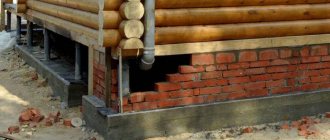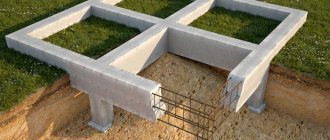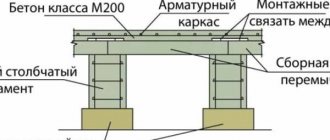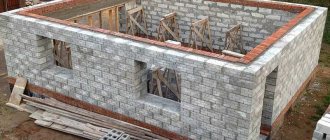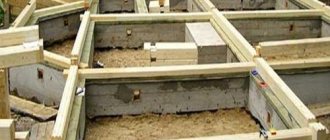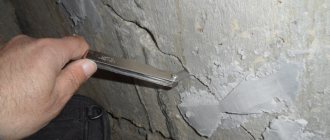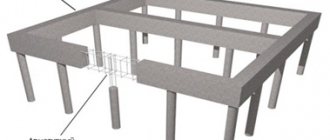Composite reinforcement is one of the modern materials designed to replace expensive rolled metal and provide greater resistance to the negative influence of external factors. After this type of polymer rod began to be produced in Russia in 2012, interest in it from builders began to increase every year.
The use of fiberglass materials for the reinforcement of monolithic concrete structures is especially important in cases of possible exposure to moisture, since polymers are not susceptible to corrosion.
Plastic rods are used at individual development sites, during the construction of large buildings and structures, for coastal fortifications and highways. In private construction, it is used to make reinforcing frames for strip and slab foundations, and also to reinforce masonry made of foam concrete blocks.
The material from which plastic fittings are made is a polymer mixture of longitudinal fiberglass of increased strength and thermally resistant resin. Standard diameters of produced rods range from 4 to 32 mm. Maximum operating temperature 60˚C. Tensile strength 150 MPa.
Preparation of materials for assembling the reinforcing frame
To increase the overall strength of a concrete monolith, it is reinforced with a structure made of fiberglass reinforcement in the form of a flat mesh or spatial frame, which is assembled from round rods of variable or constant cross-section. The individual elements of such structures are connected to each other using binding wire, fixing clamps or a special gun.
Therefore, to knit a reinforcing frame you need to purchase:
- plastic fittings of designed diameters;
- tie wire or tie clamps.
Unlike traditional metal rods, fiberglass reinforcement is supplied in the form of a coiled coil.
Therefore, before starting to assemble the frame, it must be unwound and cut into pieces of the required length. Cutting is done with a hacksaw or other tool that does not allow the material to heat up. Marking cut locations on the surface can be easily done using an ordinary marker.
The binding wire must be round in cross-section and have a diameter of at least 1 mm to ensure the necessary strength of the connection and not burst when twisted. To quickly obtain pieces of wire of the length required for knitting, the entire rolled coil must be cut into 3 or 4 parts with a grinder.
To make the binding wire softer, it can be burned in a flame using a blowtorch or in a fire. Unburnt wire bends worse and does not always provide a tight grip on the joint. In addition, unprepared metal has less ductility and is more likely to break during operation.
Knitting with clamps.
General knitting pattern.
Advantages of composite reinforcement
The advantages of composite materials are due to the use of synthetic raw materials . This provides ample opportunities to introduce the necessary physical and technical qualities of the material, and also eliminates or at least minimizes the influence of negative factors.
One way or another, most of the advantages are focused on reinforcing the foundation with composite reinforcement in order to create strong and reliable foundations for buildings and structures. So, among the advantages of synthetic rods the following stand out:
- High tensile strength . Compared to first-class steel reinforcement, the composite analogue has this characteristic 2.5 times higher;
- Manufacturers provide a guarantee of up to 100 years . As a result, the service life of the foundation increases several times;
- Temperature does not affect the properties of the reinforcement . In the corridor from – 70 to +100 ºC, the rods do not lose their technical characteristics. Moreover, at negative temperatures, the strength of composites increases by 35%;
- Based on the nature of the material used in the manufacture, it can be stated that fiberglass and other synthetic reinforcement are completely protected from corrosion processes , as well as negative acidic and alkaline effects, which is often detrimental to metal reinforcement;
- Such fittings are completely antistatic and are not electrical conductors . Accordingly, when using the material you do not have to worry about creating radio interference. And on the other hand, electromagnetic fields do not affect composite rods and their properties in any way;
- Builders do not pay attention to the thermal conductivity of metal, since the “cold bridges” formed from it can only be tolerated. However, composite reinforcement for the foundation, reviews from engineers about which note minimal thermal conductivity, eliminates heat loss , thus increasing the energy-saving function of the house;
- In addition to performance qualities, it is worth noting the ease of handling of such fittings. First of all, this is facilitated by the modest mass. For a visual example: a 100-meter rod can weigh about 10 kg . A similar steel rod will weigh about 8-9 times more;
- It would seem that, given the obvious advantages, the cost of such a material should be several times higher than metal reinforcement. But even in this indicator, composite reinforcement outperforms steel - its price is on average 30% cheaper ;
- Manufacturers produce fiberglass rods of any length and with different rib parameters .
Return to content
Wire tying tool
Using pliers for knitting is not very convenient. They do not provide the required connection coverage density and require a lot of effort. Therefore, steel wire is twisted onto reinforcing bars using special hooks or a knitting gun. Tool stores offer for sale two types of hooks designed for tying reinforcement:
- simple manual ones, which must be rotated all the time during operation;
- semi-automatic screw type, with a hook that rotates when you press the handle;
- plastic fasteners in the form of rings and vertical posts that fit onto the reinforcement.
Instead of buying a simple hook, you can make it yourself (read more about how to do this here), bending it from thick steel wire and sharpening the tip. In this case, you will have something to knit a project design from rods without purchasing a tool.
Using wire when installing composite reinforcement
Manual tying of reinforcement elements: the wire is quite soft, so this is easy to do. In the case of small binding volumes, this is quite noticeable. The use of a special crochet hook, which refers to manual work, is easier. If such a hook is missing, then you can bend a homemade version from thick wire.
Use of special mechanisms to knit with manual and electric drive. It is best to use the technique in the industrial area, when the volume of reinforcing mesh to be installed is very large.
The installation of reinforcement is carried out using special plastic installation elements, which allow maintaining the distance between the reinforcement and the formwork, since the reinforcement itself should not protrude onto the surface of concrete products. These installation elements are made in the form of glasses and stands, clamps and adapters. If there is an individual production, in order to install fiberglass reinforcement, fragments of bricks are used, and ordinary sections of vertical reinforcement are driven into the very bottom of the pit and then horizontal elements are tied to them.
Technology of manual wire knitting of fiberglass reinforcement
In order for the reinforcement frame or mesh to take on the required spatial shape and not change it when concrete is poured, all individual elements must be securely connected to each other. The most common way to do this is to use tie wire. Knitting is a simple and quick joining method that does not require high qualifications. In addition, fiberglass reinforcement simply cannot be connected by welding, and therefore this type of fastening is most suitable in this case.
The entire process of how to knit fiberglass reinforcement for a foundation can be divided into the following step-by-step steps:
- the reinforcement rolled into a coil is unwound and cut into pieces of the designed length;
- plastic clamps are put on the transverse rods of the lower reinforcing layer;
- longitudinal rods are laid on the spaced transverse elements at a specified distance from each other;
- at all intersections of the reinforcement, connections are made by twisting loops of knitting wire folded in half;
- after assembling the bottom row, vertical reinforcing elements are tied to the intersections of the outer cells;
- transverse sections are tied to the upper ends or to the middle of the vertical posts, depending on the design number of rows;
- the next row of longitudinal reinforcement is laid and knitted;
- the assembled frame is transferred and installed inside the formwork for the strip foundation.
The work can be greatly simplified if you combine fiberglass reinforcement with metal. You can prepare rectangular frames from steel rods in advance and then you will not need to perform separate knitting of vertical sections.
Use of fiberglass reinforcement
Quite often, this reinforcement is used for direct pouring of monolithic foundations, columns and walls, as well as for reinforcing brick walls in the field of road construction. Some highlight among the disadvantages the inability to use welding when installing fiberglass reinforcement, but this is far from true: the metal version of the reinforcement is also very often connected.
In order to tie the reinforcement, tightening clamps made of plastic material can be used, but steel-type binding wire, the thickness of which is 1 mm, is often used.
The nuances of knitting structures for pouring a slab foundation
Reinforcement of monolithic slab-type support bases is carried out in the form of one or two rows of meshes, depending on the design solution. Therefore, in this design, reinforcing bars are not considered as longitudinal and transverse. To raise the lower mesh above the waterproofing layer, plastic clamps are placed on the reinforcement every one and a half to two meters. This allows you to install the reinforcement cage strictly in a horizontal plane at a given height.
An important feature of assembling reinforcement for a slab foundation is that it is produced locally. This is necessary due to the large size of the structure and the impossibility of subsequent movement. Therefore, during knitting, you must be extremely careful not to step on the laid reinforcing bars and damage the structure.
In the Swedish and Finnish insulated slab (more about it in this article), it is necessary to provide for the intersection of the slab rods with the reinforcing frame of the side support strip. To do this, the rods are cut longer, placed on vertical side reinforcement frames and tied with wire.
The nuances of knitting fiberglass frames for strip foundations
Features of the assembly of reinforcement for strip foundations include the presence of lateral junctions, intersections and corners.
In places where the tapes meet under the internal walls, the connection of the perpendicular frame with the external one is made using bent U-shaped elements.
In the corners, the reinforcement is bent at a right angle or prepared L-shaped elements are tied. The overlap length of the connected rods must be at least 30 cm and at least 2 knits are performed in this area.
Fiberglass reinforcement should be bent very carefully, without using heat treatment. The elastic properties of plastic make the bending procedure quite difficult. Therefore, to assemble corners and junctions, it is recommended to buy prefabricated bent elements.
The intersections of fiberglass reinforcement under the strip foundation can be connected by straight sections or one of the intersecting structures can be assembled at the installation site.
Composite reinforcement ETIZ: areas of application and installation features
Composite reinforcement ETIZ
is a modern building material designed for reinforcing concrete or strengthening multilayer masonry walls. Composite reinforcement is also called ASC - glass-composite reinforcement, or fiberglass reinforcement. It is a rod with a spirally wound armored belt of 4 threads protruding above the rod.
Advantages of ETIZ composite reinforcement
- Strength - composite reinforcement has tensile strength characteristics that are 3 times greater than those of A500C class steel reinforcement.
- Durability - the coefficient of thermal expansion of composite reinforcement is close to the coefficient of thermal expansion of concrete, due to which no associated microdeformations or microcracks occur in the concrete structure, and the overall durability of the structure increases significantly.
- Chemical resistance - composite reinforcement has great chemical resistance in various aggressive environments, it is not subject to corrosion, which also has a positive effect on durability.
- Light weight - fiberglass reinforcement with comparable strength characteristics is 9 times lighter than steel reinforcement.
- Low thermal conductivity - due to low thermal conductivity, “cold bridges” do not form in structures, which reduces heat loss by up to 34% and, accordingly, the cost of heating the building.
- Ease of installation - reinforcing bars can be cut from a coil of any given length, fastened with plastic clamps, special fasteners, and not just with binding wire.
- Ease of transportation and storage - you can roll the reinforcement into coils, which allows you to use even passenger cars for transportation and save a lot of money.
Composite reinforcement is necessary to create durable structures that are not subject to destruction over time.
Areas of application of composite reinforcement
ETIZ composite reinforcement is used in various fields of industrial and civil construction. With its help, residential buildings are erected, factory complexes are constructed, used in the installation of technological structures, etc.
The use of composite reinforcement in foundations for low-rise buildings and cottages is especially common. In addition, composite reinforcement performs well in concrete structures. This can be wall masonry with flexible ties, as well as the installation of brick and reinforced concrete structures.
Where is composite reinforcement used?
- Foundations for houses up to 5 floors high (strip, base slabs, piles).
- Foundations of bathhouses, fences, garages.
- Cellars.
- Pools, reservoirs, canals.
- Septic tanks.
- Concrete pavements, platforms, paths, parking lots and roads.
- Walls during the construction of houses from permanent formwork.
- Embankments, piers, slabs for strengthening the coastal strip, and other coastal structures.
Features of installation of ETIZ composite reinforcement
Installation of composite reinforcement is carried out in exactly the same way as metal reinforcement. But thanks to the low weight of fiberglass reinforcement, it is possible to install the rods with plastic clamps, and not just with knitting wire.
Tools required for installation:
tape measure, angle grinder (grinder). Cutting ASK is carried out using a grinder, with a disk for cutting metal or ceramics. It is recommended to use diamond-coated discs.
Stages of work
- Preparation of formwork. For repeated use of formwork, it is recommended to cover it with glassine, which protects the structure from moisture and concrete.
- Using a building level, it is necessary to mark the area inside the formwork, within which the concrete mass will be poured. It is important to take into account here that the reinforcing mesh must be laid in the base of the foundation so that its edges are 50 mm from the boundaries of the formwork. To fulfill this condition, bricks can be laid at the bottom of the foundation.
- Now you can begin laying the reinforcement.
- At the next stage, crossbars are laid, that is, horizontal reinforcing bridges. Another technological knitting is performed here, for which nylon clamps should be used - in essence, this is a plastic tie. In this way, the rods are tied and a mesh is formed.
- The final stage is pouring the base with concrete.
Composite reinforcement in corners is laid perpendicularly so that perpendicular rods intersect each other at right angles.
Precautionary measures when working with fiberglass reinforcement
Gloves with PVC coating. When cutting reinforcement, additionally use personal respiratory protection (respirator) and eye protection (safety glasses).
CATALOG OF COMPOSITE REINFORCEMENTS ETIZ Sincerely,
Team of the Faculty of Construction Materials
#RDS-Academy



